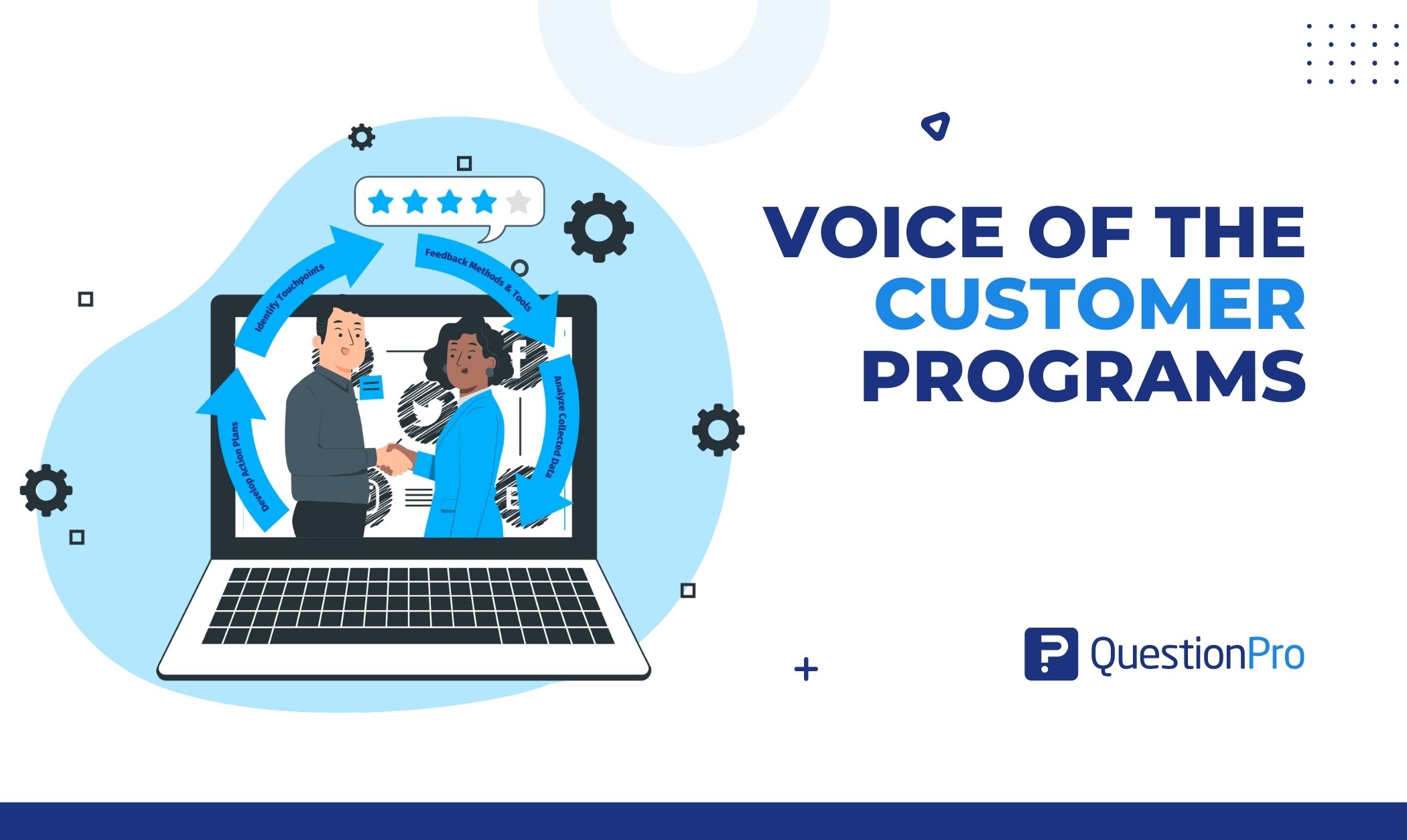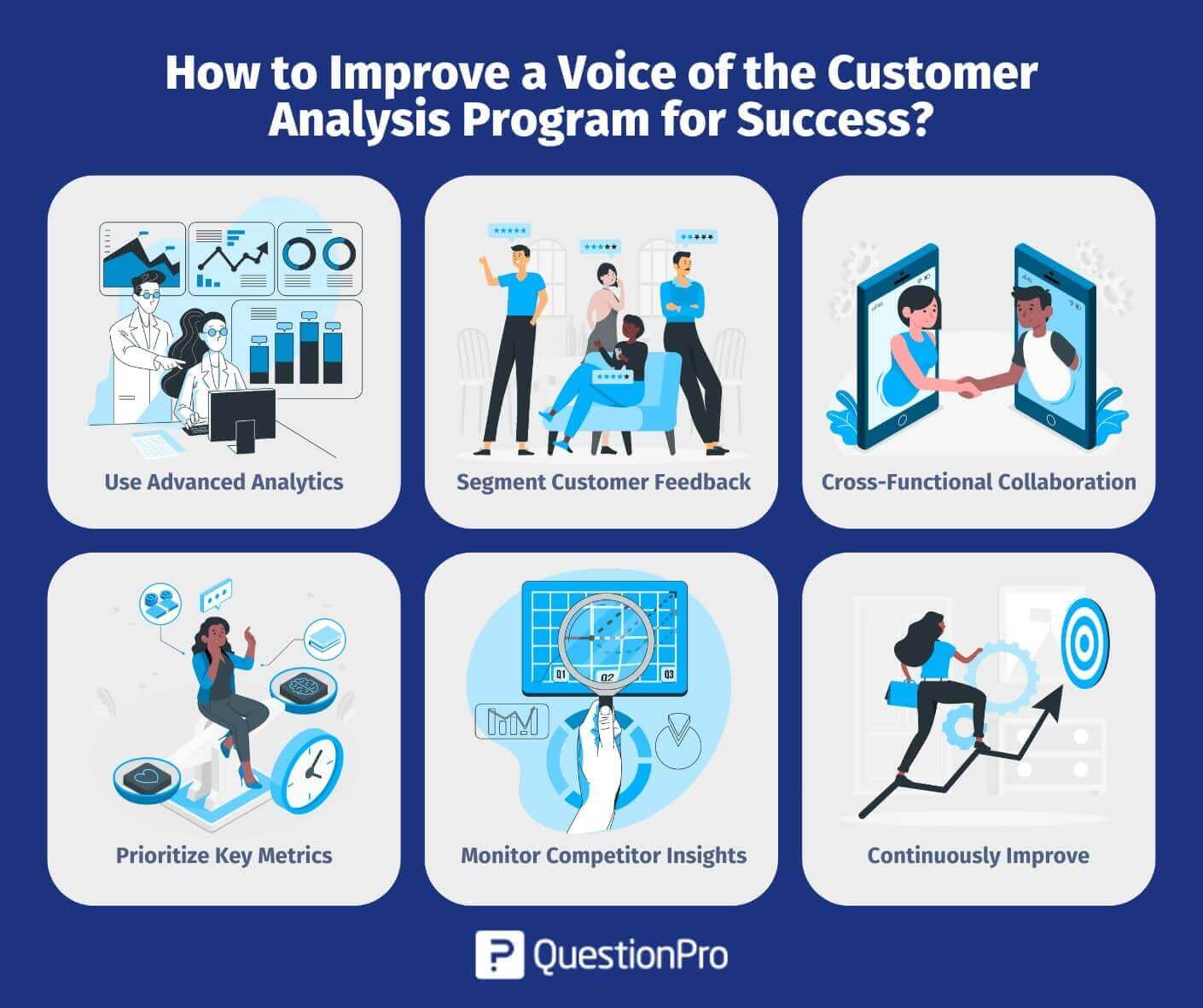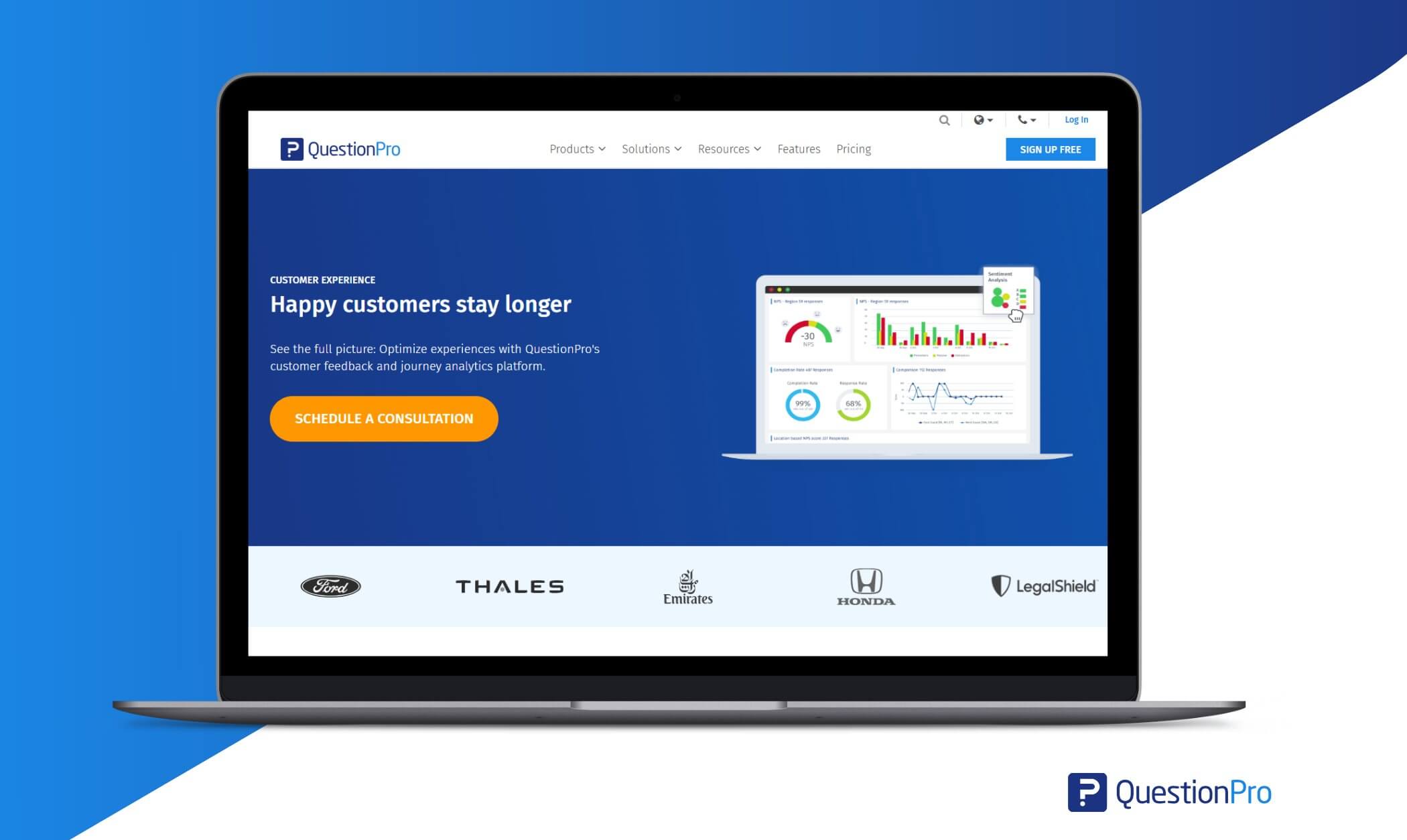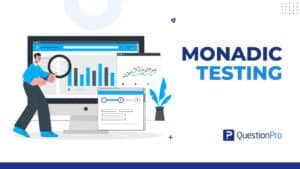
In this advanced world of business and development, understanding customers’ needs and expectations is more critical than ever. This understanding forms the backbone of any successful business strategy, allowing companies to align their products, services, and interactions with what their customers truly want. This is where Voice of the Customer Programs come into play.
Voice of the Customer (VoC) programs are designed to capture, analyze, and act upon customer feedback in a structured manner. They enable businesses to gather insights that drive improvements and innovations, increasing customer satisfaction and loyalty.
In this blog, we will guide you through the essentials of VoC programs, the importance of Voice of the Customer, steps to build a successful program, key challenges, and how tools like QuestionPro Customer Experience can enhance your VoC initiatives.
What Is a Voice of the Customer Program?
A Voice of the Customer (VoC) program systematically collects and analyzes customer feedback to gain insights into customer preferences, needs, expectations, and experiences.
The ultimate goal of a VoC program is to use these customer insights to improve products, services, and customer interactions, thus driving customer satisfaction and customer loyalty.
Components of a VoC Program:
- Feedback Collection: This involves gathering data through surveys, interviews, social media, online reviews, and more.
- Data Analysis: Once feedback is collected, it needs to be analyzed to identify trends, pain points, and opportunities for improvement.
- Action Planning: Based on the insights from VoC data analysis, businesses can create actionable plans to address customer issues and enhance their offerings.
- Implementation and Monitoring: Continuous, direct feedback loops ensure businesses stay aligned with evolving customer expectations.
- Reporting and Communication: Sharing insights and actions taken with internal teams and customers fosters transparency and trust.
Why is the Voice of the Customer Program Important?
The Voice of the Customer (VoC) program is critical for any business aiming to thrive in a competitive market. Here’s why it holds such significance:
- Customer-Centric Strategy: VoC puts the customer at the core of your business, helping products and experiences match their expectations.
- Product and Service Improvement: Ongoing feedback highlights areas for improvement and innovation, driving continuous improvement.
- Customer Retention: Responding to feedback demonstrates that you’re listening, which boosts loyalty and reduces churn.
- Competitive Advantage: Understanding and reacting to customer needs faster than competitors helps you stand out.
- Data-Driven Decisions: VoC provides real insights, not guesses, so your business decisions are more innovative and more effective.
Implementing a strong VoC program isn’t just about collecting feedback; it’s about acting on it. By focusing on what your customers truly want, you can drive smarter decisions, improve retention, and stay ahead of the competition, all while building lasting relationships.
How to Build a Voice of the Customer Program
Building a successful VoC program requires a strategic approach. Here are the key steps to consider:
Step 1: Define Objectives
Before collecting data, clearly define what you aim to achieve with your VoC program. Are you looking to improve customer satisfaction, enhance product offerings, or boost customer loyalty? Well-defined objectives will guide your efforts and help you measure success.
Step 2: Identify Touchpoints
Determine the key touchpoints where customers interact with your brand. This could include your
- Website,
- Customer service,
- Social media channels,
- Physical stores, and more.
Understanding these touchpoints helps you gather feedback at the most relevant stages of the customer journey.
Step 3: Choose Feedback Methods and Tools
Select the appropriate methods for collecting customer feedback. Examples include :
- Surveys.
- Interviews.
- Focus groups.
- Social media listening.
- Online reviews.
The choice of method will depend on your objectives, target audience, and available resources. To streamline the process, invest in feedback platforms like QuestionPro Customer Experience, which offers powerful survey features, sentiment analysis, and real-time reporting.
Step 4: Analyze Collected Data
Once VoC feedback is collected, analyze the data to uncover trends, patterns, and pain points. Look for recurring themes and prioritize areas that require immediate attention. Advanced analytics techniques, such as text and sentiment analysis, can provide deeper insights into customer sentiments.
Step 5: Develop Action Plans
Translate insights into actionable plans. Collaborate with relevant teams to address identified issues and implement improvements. Ensure that action plans are SMART:
- Specific.
- Measurable.
- Achievable.
- Relevant.
- Time-bound.
Step 6: Implement Changes and Communicate Results
Put your action plans into motion and monitor their impact using key customer metrics. Once improvements are made, share the results with your internal teams and customers to show that their feedback leads to real change, reinforcing your commitment to continuous improvement.
A successful VoC program is an ongoing process. Gather feedback, analyze data, and adapt your strategies to meet evolving customer expectations.
How to Improve a Voice of the Customer Analysis Program for Success?
Improving a dynamic VoC analysis program requires careful planning and execution. It’s about more than collecting feedback; it’s about turning that feedback into actions that enhance the customer experience. Here’s how you can ensure success:

1. Use Advanced Analytics
Leverage advanced analytics techniques such as sentiment analysis, text mining, and machine learning to extract meaningful insights from customer feedback. These techniques can help.
- Identify sentiment trends.
- Detect emerging issues.
- Predict customer behavior.
2. Segment Customer Feedback
Segment customer feedback based on demographics, purchase history, and engagement levels. This segmentation allows you to optimize your responses and actions to specific customer groups, enhancing personalization and relevance.
3. Cross-Functional Collaboration
VoC analysis should involve collaboration across departments. Marketing, sales, product development, and customer support teams should collaborate to interpret insights and implement changes that benefit the organization.
4. Prioritize Key Metrics
Focus on key performance indicators (KPIs) that align with your objectives. Tracking these metrics provides a clear picture of customer sentiment and program effectiveness. Common VoC metrics include
- Net Promoter Score (NPS).
- Customer Satisfaction Score (CSAT).
- Customer Effort Score (CES).
- Customer Churn Rate.
5. Monitor Competitor Insights
Collect customer feedback data and analyze it related to competitors to identify areas where your brand can gain a competitive advantage. Understanding how customers perceive your competitors can provide valuable insights for positioning your offerings.
6. Continuously Improve
Review and refine your VoC analysis program regularly. Adapt your strategies based on new insights and emerging customer trends. A culture of continuous improvement ensures that your program remains practical and relevant.
Key Challenges of Voice of the Customer Programs
An effective customer strategy is essential for creating an exceptional customer experience that builds loyalty and satisfaction. Despite their benefits, VoC programs can face several challenges:
- Data Overload: Collecting vast amounts of data can lead to information overload, making it challenging to extract meaningful insights.
- Integration with Existing Systems: Integrating VoC software with existing CRM and other systems can be complex and time-consuming.
- Maintaining Customer Engagement: Keeping customers engaged and motivated to provide feedback can be challenging.
- Ensuring Data Privacy: Safeguarding customer data and compliance with privacy regulations is paramount.
- Turning Insights into Action: Transforming data-driven insights into actionable strategies requires effective collaboration and communication.
How QuestionPro Customer Experience Can Help Build Voice of the Customer Programs?
QuestionPro Customer Experience is a leading platform that empowers businesses to effectively manage and optimize their Voice of the Customer programs. Here’s how QuestionPro Customer Experience can make a difference:

- Multiple feedback channels: Collect insights through online surveys, email, website pop-ups, in-app feedback, and more, meeting customers wherever they are.
- VoC survey templates: Launch faster with ready-made templates tailored to every stage of the customer journey, from onboarding to post-support.
- Real-time analytics & dashboards: Instantly visualize customer sentiment, satisfaction scores, and key trends with dynamic dashboards.
- Advanced segmentation & filters: Drill into feedback by customer type, location, product, or journey stage for more targeted insights.
- Text and sentiment analysis: Go beyond numbers, analyze open-ended comments to detect emotional tone, recurring themes, and root causes.
- CX-specific features: Track key metrics like NPS, CSAT, and CES with built-in survey logic, benchmarking tools, and automated reporting.
Conclusion
Voice of the Customer programs go beyond collecting feedback; they turn insights into real impact. We learned about VoC programs, how to build them, the challenges they face, and more from the article.
With platforms like QuestionPro Customer Experience, collecting and analyzing feedback becomes more efficient and insightful. From real-time dashboards to sentiment analysis, these tools enable teams to transform raw customer input into actionable strategies that enhance products, services, and customer relationships.
By systematically collecting and analyzing customer feedback, organizations can make informed decisions that enhance their products, services, and overall brand perception. Stay focused, act on what you learn, and let your customers’ voices shape the future of your business.
Frequently Asked Questions(FAQs)
Answer: Feedback can be gathered through various channels such as surveys, interviews, focus groups, social media listening, and online reviews. The choice depends on your goals and customer touchpoints.
Answer: Platforms like QuestionPro Customer Experience offer features like ready-made survey templates, multi-channel feedback collection, real-time dashboards, and sentiment analysis to make VoC programs more efficient and actionable.
Answer: By analyzing trends and pain points in the data, businesses can develop SMART action plans that are specific, measurable, achievable, relevant, and time-bound, and monitor their impact over time.
Answer: Common challenges include data overload, system integration issues, customer engagement fatigue, data privacy concerns, and difficulty turning insights into meaningful actions.
Answer: Key metrics include Net Promoter Score (NPS), Customer Satisfaction Score (CSAT), Customer Effort Score (CES), and churn rate. These help evaluate customer sentiment and program success.







